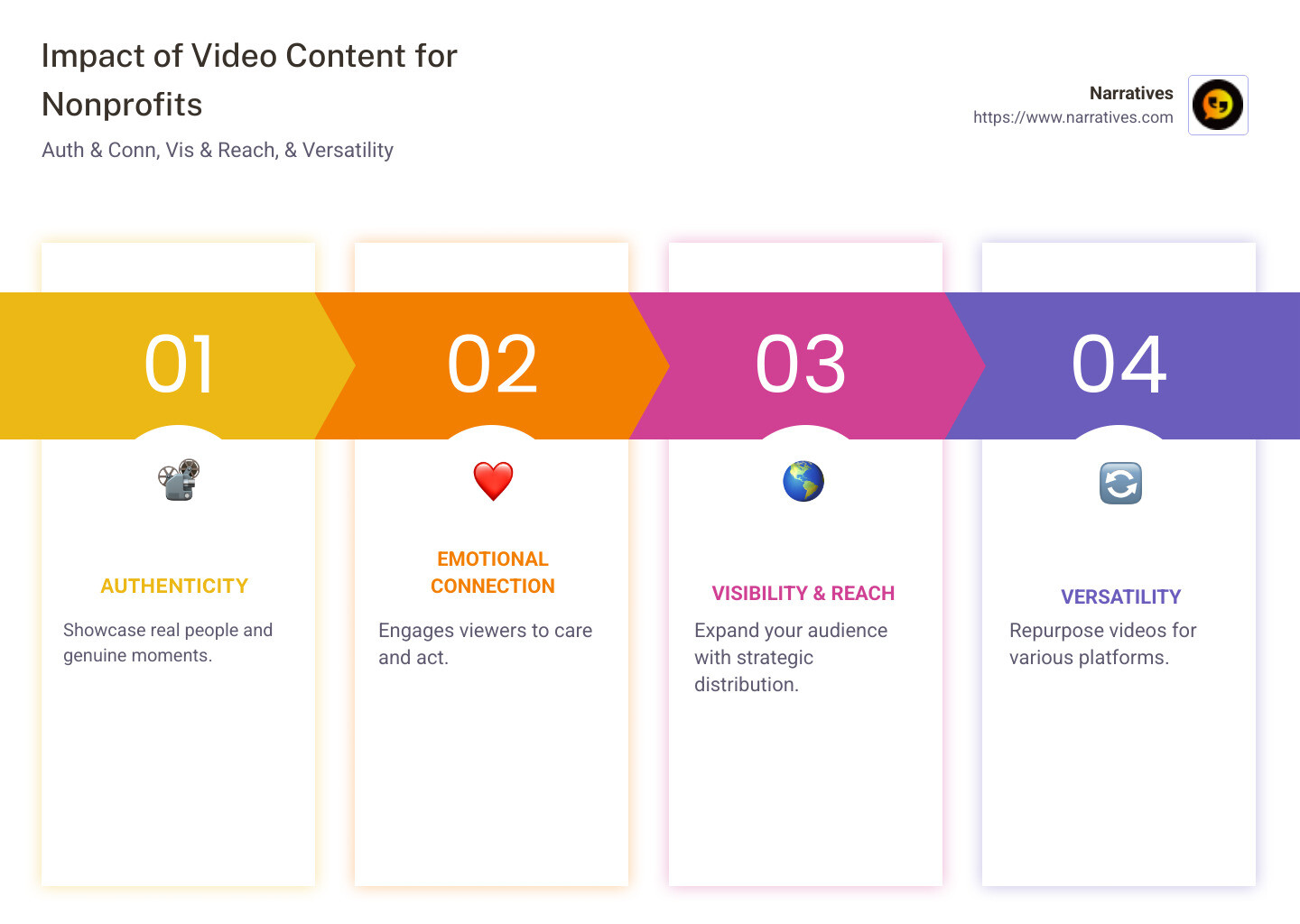Beyond the Lens: Crafting Compelling Nonprofit Videos

Video content for nonprofits is crucial for making an impact. In the digital world, video is a powerful tool that blends storytelling with nonprofit missions to create meaningful connections and drive change. Here’s why it matters:
- Authenticity: Videos bring stories to life, showcasing real people and genuine moments.
- Emotional Connection: They tap into the heart, encouraging viewers to care and act.
- Visibility and Reach: With smart distribution, a video can reach a vast audience.
- Versatility: Repurpose for campaigns, social media, or donor outreach.
Imagine a viewer stumbling upon an advocacy video from a passionate YouTube creator supporting LGBTQ+ rights. Their campaign for a nonprofit organization raised significant funds, proving videos can inspire action. Nonprofits can harness this power to share stories of change, hope, and community resilience.
As we dive deeper, consider your own stories and the impact they could have when crafted into compelling videos.

The Power of Video Content for Nonprofits
Authenticity, emotional connection, and brand humanization are the backbone of video content for nonprofits. These elements transform simple videos into powerful tools for change.
Authenticity
Videos allow nonprofits to share real stories. They bring viewers into the heart of the mission, showcasing the genuine experiences of those they help. This authenticity builds trust. When viewers see real people and true stories, they are more likely to connect with the cause.
Emotional Connection
Videos tap into emotions like no other medium. They can make viewers laugh, cry, and feel inspired. This emotional engagement is crucial for nonprofits. It encourages viewers to care deeply about the cause and motivates them to take action.
Consider the success of personal videos in crowdfunding campaigns. Those with videos raise 150% more than those without. This highlights the power of emotional storytelling in driving support and donations.
Brand Humanization
Through video, nonprofits can humanize their brand. They show the faces behind the mission and the stories of those they help. This makes the organization more relatable and approachable.
A great example is the "Why Water" explainer video by BUCK Animation for charity: water. It quickly connects with viewers, making the mission clear and engaging. The animated elements and compelling storytelling breathe life into the cause, making viewers feel involved and inspired to help.
By focusing on authenticity, emotional connection, and brand humanization, nonprofits can create videos that not only capture attention but also inspire action. As we explore the different types of nonprofit videos, think about how these elements can improve your storytelling approach.
Types of Nonprofit Videos
Crafting video content for nonprofits involves choosing the right type of video to convey your message. Each type serves a unique purpose, helping you connect with your audience in different ways. Let's explore the core types every nonprofit should consider:
Story Videos
Story videos are the heart of nonprofit storytelling. They take viewers on an emotional journey, showcasing the real impact of your mission. These videos are typically longer, ranging from 2 to 6 minutes, allowing for a deep dive into personal stories.
A great example is the “One Million Lives” video by Tectonic Video for Village Enterprises. It shares a beneficiary's journey out of poverty, using testimonials and visuals to create an immersive experience. Such storytelling not only highlights the mission but also makes viewers feel a personal connection to the cause.

Explainer Videos
Explainer videos break down complex processes or services into simple, digestible content. They are short and often use motion graphics or animations to keep viewers engaged.
For example, charity: water's "Why Water" video uses animation to explain the importance of clean water, making the information accessible and engaging. These videos are ideal for sharing across social media, where quick and clear messages perform best.
Campaign Videos
When launching a fundraising or advocacy campaign, a campaign video is essential. These videos are designed to inspire immediate action, whether it’s donating or volunteering. They highlight the urgency and importance of the campaign, often featuring a strong call-to-action.
Campaign videos can be embedded on donation pages, sent through email campaigns, or shared on social media to maximize reach and impact.
Testimonial Videos
Testimonial videos feature the voices of your members, donors, and volunteers. They provide first-hand perspectives on your nonprofit's impact, adding credibility and authenticity.
These videos are powerful recruitment tools, as they showcase the positive experiences of those involved with your organization. Hearing directly from peers can be more persuasive than any written content.
Organizational Videos
Every nonprofit needs an organizational video, sometimes called a brand film. This video introduces who you are, what your mission is, and why you deserve support. It’s a versatile asset that can be used across multiple platforms and campaigns.
An organizational video is your chance to make a strong first impression, so ensure it reflects your mission and values clearly and engagingly.
By understanding and utilizing these different types of videos, nonprofits can effectively communicate their mission and inspire action. Each type plays a crucial role in building connections, driving engagement, and ultimately supporting the cause.
Creating High-Quality Nonprofit Videos
Creating high-quality video content for nonprofits demands a structured approach. Let's break down the process into three essential phases: pre-production, production, and post-production. A professional approach is key to ensuring your videos stand out and effectively convey your mission.
Pre-Production
Pre-production is all about planning. It's the most crucial phase and sets the foundation for your video.
Strategy & Story Selection: Define your goals and choose a story that aligns with your mission. What message do you want to convey? Who is your audience?
Audience Research: Understand your audience's preferences and tailor your content to resonate with them.
Scriptwriting & Storyboarding: Write a compelling script and create a storyboard to visualize the flow of your video.
Location Scouting: Choose locations that improve your narrative and are logistically feasible.
This phase can take time, but a well-thought-out plan ensures a smooth production process.
Production
This is where your vision comes to life. It's all about capturing the story.
Equipment Setup: Use quality cameras, lighting, and sound equipment to ensure professional-grade footage.
Conducting Interviews: Capture authentic stories from your subjects. Genuine emotions resonate with viewers.
B-Roll Footage: Gather additional footage to support and enrich your main narrative.
Graphics & Animations: If applicable, create engaging animations or graphics to simplify complex information.
Post-Production
Once filming is complete, it's time to assemble your video.
Editing: Select the best clips and sequence them to create a cohesive narrative. Keep the video concise to maintain viewer engagement.
Music & Sound Design: Choose music that complements your story and improves the emotional impact.
Final Review & Approval: Review the video with your team to ensure it aligns with your goals and make necessary adjustments.
Distribution Plan: Decide where and how you'll share your video. Social media, websites, and events are great platforms to reach your audience.
Professional Approach
While anyone can make a video with a smartphone, a professional approach lifts your content. Consider hiring a nonprofit video production company if resources allow. Their expertise can transform your vision into a polished product that effectively communicates your message.
The quality of your video reflects your organization's credibility and commitment to its mission. By investing time and resources into each phase, you ensure your video content for nonprofits is impactful and inspiring.
Next, let's explore the best practices for nonprofit video storytelling, focusing on creating a compelling narrative that resonates with viewers.
5 Best Practices for Nonprofit Video Storytelling
Creating a compelling nonprofit video is more than just capturing footage. It's about storytelling that resonates with hearts and minds. Here are five best practices to help you craft impactful narratives:
1. Narrative Arc
Every great story has a beginning, middle, and end. This structure, known as the narrative arc, keeps your audience engaged from start to finish. Start by introducing the problem or mission, then show the journey or process, and conclude with the resolution or impact.
Consider the example of the "One Million Lives" video by Tectonic Video. It follows a beneficiary's journey out of poverty, showcasing the phases of change. This arc not only informs but also inspires viewers to become part of the change.
2. Compelling Characters
Characters are the soul of your story. They humanize your mission and make it relatable. Use real people who can share their authentic experiences. Their emotions and stories will connect with your audience on a personal level.
For instance, testimonial videos featuring members, donors, or beneficiaries can powerfully convey your organization's impact through perspectives. These characters help viewers see the real-world effects of your work.
3. Clear Call-to-Action
A strong call-to-action (CTA) is crucial. After engaging your audience emotionally, guide them on what to do next. Whether it's donating, volunteering, or sharing your video, make the CTA clear and actionable.
Campaign videos often excel in this area. They not only explain the importance of a specific campaign but also detail how supporters can get involved, making the transition from viewer to participant seamless.
4. Emotional Engagement
Emotion is a potent tool in storytelling. It drives action and fosters connections. Use visuals, music, and storytelling techniques to evoke feelings of empathy, hope, or urgency.
The "One Million Lives" video uses angles, colors, and audio to create an emotional and immersive experience. This approach ensures viewers are not just watching but feeling every moment, making them more likely to support your cause.
5. Concise Messaging
Keep your message clear and to the point. Attention spans are short, so avoid unnecessary details. Focus on your core message and deliver it succinctly.
Explainer videos are a great example of concise storytelling. They break down complex processes into digestible, easy-to-understand segments, ensuring viewers grasp your mission quickly and effectively.
By implementing these best practices, your video content for nonprofits can become a powerful tool to inspire action and drive your mission forward.
Next, we’ll answer some frequently asked questions about nonprofit videos to help you further refine your strategy.
Frequently Asked Questions about Video Content for Nonprofits
What is a nonprofit video?
A nonprofit video is a visual storytelling tool designed to inspire action and support for a cause. These videos can take many forms, such as explainer videos, fundraising campaigns, or storytelling pieces. They are used across various platforms—like social media, websites, and events—to engage audiences and communicate a nonprofit's mission effectively.
Why are nonprofit videos important?
Nonprofit videos are crucial because they help convey the organization's message in a compelling and engaging way. They can increase awareness, drive donations, and build a community around the cause. By using emotional storytelling and impactful visuals, these videos can effectively connect with viewers and motivate them to take action.
How long should a nonprofit video be?
The ideal length for a nonprofit video is around two to three minutes. This duration is optimal for maintaining viewer engagement, as longer videos often see a drop-off in attention. However, the length can vary based on the video's purpose and the platform it's featured on. For instance, a quick explainer video on social media might be shorter, while a detailed storytelling piece on a website could be longer.
By understanding these key aspects of video content for nonprofits, you'll be better equipped to create engaging and effective videos that resonate with your audience.
Next, we'll explore the conclusion of our guide, focusing on the role of narratives and digital storytelling in creating community-driven impact.
Conclusion
In the changing landscape of nonprofit communication, video content for nonprofits stands out as a vital tool for creating real change. At Narratives, we believe in the power of digital storytelling to lift underrepresented voices and share impactful stories that resonate with audiences.
Narratives is more than just a content agency; we're your partner in crafting stories that matter. Our approach focuses on amplifying the voices of those working tirelessly to improve their communities. By creating high-quality, emotionally resonant videos, we help nonprofits build trust, inspire action, and increase visibility.
Consider the success of the "Why Water" video by BUCK Animation for charity: water. This explainer video quickly connects with its audience, changing a serious topic into an engaging experience. It serves as a powerful example of how storytelling can humanize a brand and drive action.
Similarly, the "High Jump Chicago" campaign video by Delack Media Group illustrates the importance of personalizing messages. By targeting Chicagoans specifically, the video creates a more intimate connection with its audience, increasing engagement and support.
These examples highlight the impact of community-driven storytelling. By focusing on compelling narratives and authentic voices, nonprofits can foster a deeper connection with their audiences. This not only encourages support but also builds a community around your cause.
At Narratives, we're committed to helping nonprofits harness the power of video to make a difference. Whether you're looking to share a powerful story or drive a social impact campaign, our team is here to support you every step of the way.
Ready to lift your nonprofit's storytelling? Find how Narratives can help you create compelling video content that inspires and engages. Let's work together to make your mission heard and drive meaningful change.



